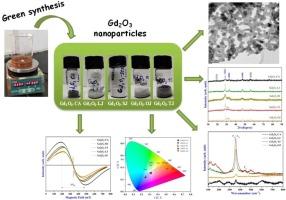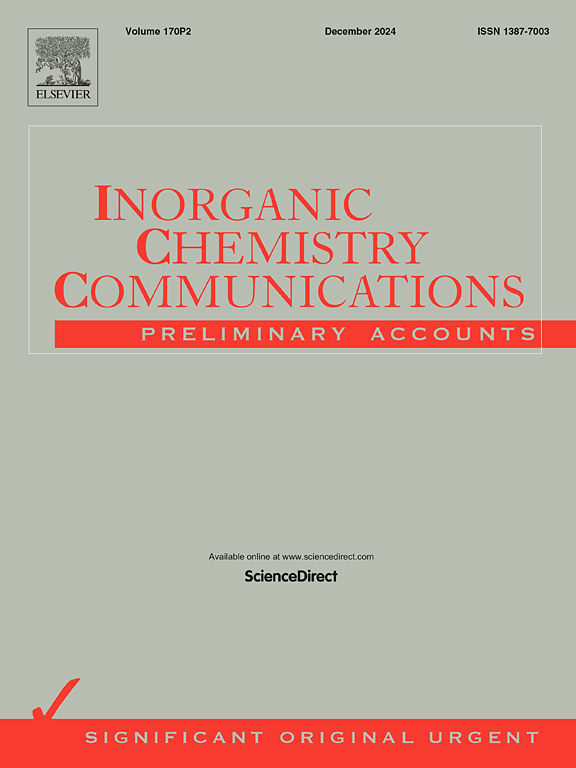Structural, optical, luminescent and magnetic properties of Gd2O3 nanoparticles: A comparative study on the effect of different green fuels in the sol–gel synthesis tactics
IF 4.4
3区 化学
Q1 CHEMISTRY, INORGANIC & NUCLEAR
引用次数: 0
Abstract
In this study, five samples of Gd2O3 NPs (size range: 4–33 nm) were synthesized by five different green facile and diverse natural products acting as reducing & stabilizing agents such as: fresh juices of sugarcane, lemon, tomato & orange fruits and citric acid via self-combustion sol–gel tactics. Powder X-ray diffraction (PXRD), High resolution transmission electron microscopy (HRTEM), Fourier transform infrared (FTIR) and Raman analysis affirmed cubic-C type crystal structure of Gd2O3 NPs prepared using citric acid, lemon juice and sugarcane juice. Mixed cubic and monoclinic phases were observed in Gd2O3 NPs prepared using tomato and orange juices. Notably, NPs of Gd2O3 in quantum dot regime (size: 6 ± 2 nm) were produced in the fresh sugarcane juice mediated synthesis protocol. Fresh lemon juice and sugarcane juice were appeared to be the most efficient green fuel for producing quality samples of Gd2O3 NPs. Optical absorption studies showed that bandgap in these Gd2O3 NPs is strongly dependent on the preparation protocol and type of green fuel. Interestingly, highest and lowest band gap of 4.91 eV and 4.43 eV were obtained for Gd2O3 NPs fabricated with orange and lemon juices, respectively. Photoluminescence (PL) and electron spin resonance (ESR) analysis affirmed formation of Schottky and Frenkel surface defects along with self trapped excitons and oxygen vacancies in these Gd2O3 NPs. Paramagnetic character of these Gd2O3 NPs at 300 K is validated by dc-magnetization and ESR studies. Present study demonstrated that microstructural, optical absorption and photoluminescence properties of Gd2O3 NPs can be easily customized by choice of natural products in the synthesis tactics.

Gd2O3 纳米粒子的结构、光学、发光和磁学特性:不同绿色燃料对溶胶-凝胶合成法影响的比较研究
本研究以甘蔗汁、柠檬汁、番茄汁、橙汁和柠檬酸等五种不同的绿色天然产品为还原剂和稳定剂,通过自燃烧溶胶-凝胶法合成了五种 Gd2O3 NPs 样品(尺寸范围:4-33 nm)。粉末 X 射线衍射(PXRD)、高分辨率透射电子显微镜(HRTEM)、傅立叶变换红外(FTIR)和拉曼分析证实了使用柠檬酸、柠檬汁和甘蔗汁制备的 Gd2O3 NPs 的立方-C 型晶体结构。在使用番茄汁和橙汁制备的 Gd2O3 NP 中观察到了立方和单斜混合相。值得注意的是,在新鲜甘蔗汁介导的合成方案中,生成了量子点状的 Gd2O3 NPs(尺寸:6 ± 2 nm)。新鲜柠檬汁和甘蔗汁似乎是生产优质 Gd2O3 NPs 样品最有效的绿色燃料。光学吸收研究表明,这些 Gd2O3 NPs 的带隙与制备方案和绿色燃料的类型密切相关。有趣的是,用橙汁和柠檬汁制备的 Gd2O3 NPs 的最高和最低带隙分别为 4.91 eV 和 4.43 eV。光致发光(PL)和电子自旋共振(ESR)分析证实,在这些 Gd2O3 NPs 中形成了肖特基和弗伦克尔表面缺陷以及自陷激子和氧空位。直流磁化和 ESR 研究验证了这些 Gd2O3 NPs 在 300 K 时的顺磁性。目前的研究表明,在合成过程中选择天然产品可以轻松定制 Gd2O3 NPs 的微观结构、光吸收和光致发光特性。
本文章由计算机程序翻译,如有差异,请以英文原文为准。
求助全文
约1分钟内获得全文
求助全文
来源期刊

Inorganic Chemistry Communications
化学-无机化学与核化学
CiteScore
5.50
自引率
7.90%
发文量
1013
审稿时长
53 days
期刊介绍:
Launched in January 1998, Inorganic Chemistry Communications is an international journal dedicated to the rapid publication of short communications in the major areas of inorganic, organometallic and supramolecular chemistry. Topics include synthetic and reaction chemistry, kinetics and mechanisms of reactions, bioinorganic chemistry, photochemistry and the use of metal and organometallic compounds in stoichiometric and catalytic synthesis or organic compounds.
 求助内容:
求助内容: 应助结果提醒方式:
应助结果提醒方式:


